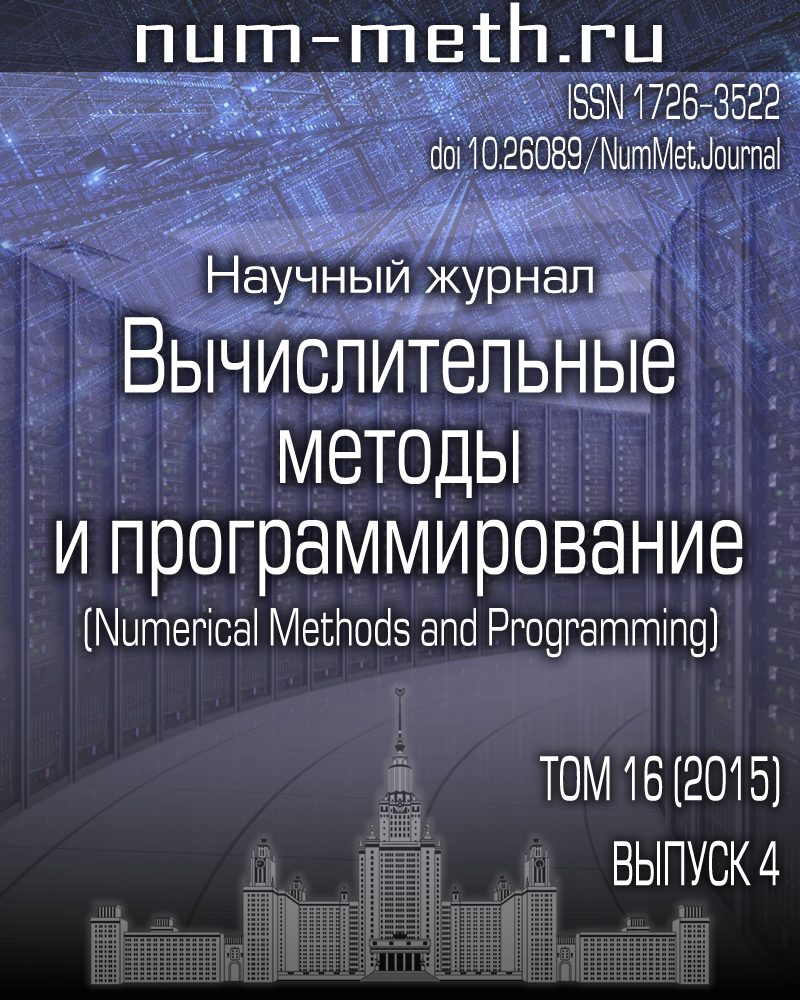DOI: https://doi.org/10.26089/NumMet.v16r447
Итерационный метод определения формы и проводимости однородного вкрапления в двумерной задаче электроимпедансной томографии
Ключевые слова:
электроимпедансная томография
кусочно-постоянная проводимость
итерационный метод
метод регуляризации Тихонова
Аннотация
Рассматривается двумерная задача электроимпедансной томографии в случае ограниченной области с кусочно-постоянным коэффициентом электрической проводимости, принимающим два значения. Требуется определить неизвестную кривую, разделяющую области с различной проводимостью, и восстановить значение проводимости внутри одной из этих областей по измерениям характеристик электрического поля на известной внешней границе области. Предлагается итерационный метод численного решения поставленной задачи, приводятся результаты вычислительных экспериментов.
Опубликован
2015-09-06
Выпуск
Раздел
Раздел 1. Вычислительные методы и приложения
Библиографические ссылки
- L. Borcea, “Electrical Impedance Tomography,” Inverse Probl. 18 (6), 99-136 (2002).
- G. J. Saulnier, R. S. Blue, J. C. Newell, et al., “Electrical Impedance Tomography,” IEEE Sig. Proc. Mag. 18 (6), 31-43 (2001).
- M. Hanke and M. Brühl, “Recent Progress in Electrical Impedance Tomography,” Inverse Probl. 19 (6), S65-S90 (2003).
- G. Alessandrini and V. Isakov, “Analyticity and Uniqueness for the Inverse Conductivity Problem,” Rend. Ist. Mat. Univ. Trieste 28, 351-369 (1996).
- B. Barceló, E. Fabes, and J. K. Seo, “The Inverse Conductivity Problem with one Measurement: Uniqueness for Convex Polyhedra,” Proc. Amer. Math. Soc. 122 (1), 183-189 (1994).
- H. Bellout, A. Friedman, and V. Isakov, “Stability for an Inverse Problem in Potential Theory,” Trans. Amer. Math. Soc. 332 (1), 271-296 (1992).
- K. Astala and L. P854iv854rinta, “Calderón’s Inverse Conductivity Problem in the Plane,” Ann. Math. 163, 265-299 (2006).
- H. Kang, J. K. Seo, and D. Sheen, “Numerical Identification of Discontinuous Conductivity Coefficients,” Inverse Probl. 13 (1), 113-123 (1997).
- M. Brühl and M. Hanke, “Numerical Implementation of Two Noniterative Methods for Locating Inclusions by Impedance Tomography,” Inverse Probl. 16 (4), 1029-1042 (2000).
- H. Eckel and R. Kress, “Nonlinear Integral Equations for the Inverse Electrical Impedance Problem,” Inverse Probl. 23 (2), 475-491 (2007).
- K. Knudsen, M. Lassas, J. L. Mueller, and S. Siltanen, “Regularized D-Bar Method for the Inverse Conductivity Problem,” Inverse Probl. Imaging 3 (4), 599-624 (2009).
- M.-E. Ts, E. Lee, J. K. Seo, et al., “Projective Electrical Impedance Reconstruction with Two Measurements,” SIAM J. Appl. Math. 73 (4), 1659-1675 (2013).
- A. M. Denisov, E. V. Zakharov, A. V. Kalinin, and V. V. Kalinin, “Numerical Methods for Some Inverse Problems of Heart Electrophysiology,” Differ. Uravn. 45 (7), 1014-1022 (2009) [Differ. Equ. 45 (7), 1034-1043 (2009)].
- S. V. Gavrilov, “Numerical Conditioning Analysis of Two-Dimensional Problems in Electrical Impedance Tomography,” Vychisl. Metody Programm. 15, 329-336 (2014).
- S. V. Gavrilov and A. M. Denisov, “Numerical Methods for Determining the Inhomogeneity Boundary in a Boundary Value Problem for Laplace’s Equation in a Piecewise Homogeneous Medium,” Zh. Vychisl. Mat. Mat. Fiz. 51 (8), 1476-1489 (2011) [Comput. Math. Math. Phys. 51 (8), 1377-1390 (2011)].

